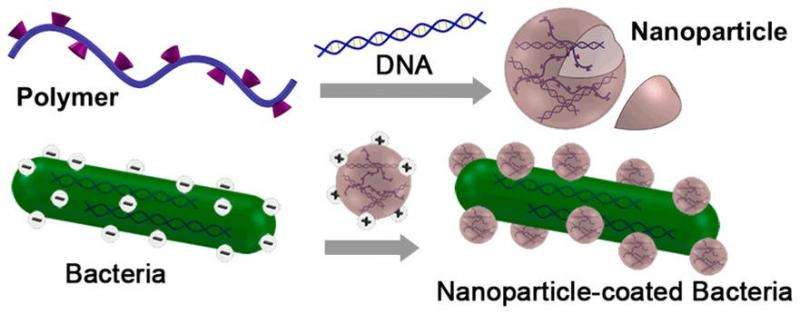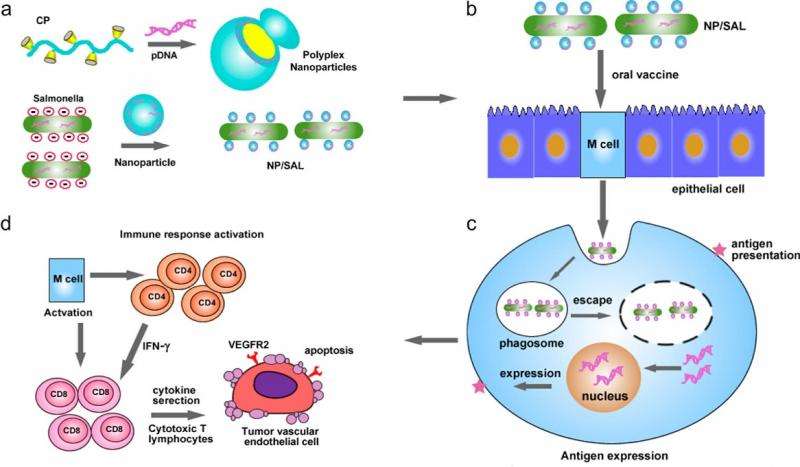April 16, 2015 feature
Nanoparticle-coated bacteria can deliver cancer vaccine

Marking an important step in the development of immunotherapy cancer treatment, scientists have demonstrated that nanoparticle-coated bacteria can effectively deliver an oral DNA vaccine that stimulates the body's own immune system to destroy its cancer cells. This is the first time that a nanoparticle coating has been used for bacterial delivery of oral DNA vaccination in vivo. Compared with uncoated bacteria, coated bacteria can bypass many of the roadblocks that have so far limited the immune response and that currently pose the biggest challenge to DNA vaccinations against cancer.
The researchers, led by Yuan Ping at Nanyang Technological University in Singapore and Guping Tang at Zhejiang University in Hangzhou, China, have published their study on using the nanoparticle-coated bacteria for oral DNA vaccines in a recent issue of Nano Letters.
"The most significant aspect of our work is to provide an important delivery solution to effectively improve the oral bioavailability of cancer vaccines," Ping told Phys.org. "Although some delivery materials that are able to protect antigen in transit through the stomach and gut for oral vaccination have long been investigated, only a few could successfully surmount substantial hurdles to oral vaccine development. Our engineered 'living materials' that combine the advantages of live cells with non-living nanomaterials successfully break the bottlenecks of oral DNA vaccines delivery, and have produced a new method of treating cancer that effectively increases the strength of immune responses against tumors by stimulating the activities of specific components of the immune system."
Helpful bacterial infections
In general, immunotherapy is considered to be a promising alternative to current forms of cancer treatment such as chemotherapy and radiation, which directly attack and destroy cancer cells but often damage healthy cells in the process. Because immunotherapy stimulates the body's own immune system to target and destroy cancer cells, it has the potential to be much safer and cause fewer side effects than other treatments.
One oral DNA vaccine that researchers have been working on is called NP/SAL, which suppresses tumor angiogenesis (blood vessel formation). Many tumors secrete angiogenic factors such as vascular endothelial growth factor (VEGF) to promote blood vessel formation, which can eventually lead to tumor metastasis. The NP/SAL vaccine stimulates the immune system to produce T cells (white blood cells) and cytokines (chemical messengers), which in turn interfere with the VEGF pathway, reducing blood vessel formation and ultimately inhibiting tumor growth.
Although this strategy is effective if it can evoke a sufficiently strong immune response, the challenge lies in getting the vaccine to the right place, which is the lower gut, from where it is disseminated into the blood. One way to do this is by inserting the vaccine into the DNA of live bacteria such as Salmonellae that have been attenuated, i.e., their toxicity has been reduced to safe levels. When the vaccine (carried by the bacteria) is administered to a patient, the bacteria invade the body as in a typical bacterial infection, colonizing, reproducing, and spreading their DNA and the vaccine with it.
Before the vaccine can evoke the desired immune response, however, it must overcome two major hurdles. First, the bacteria encounter a common immune response in which white blood cells called macrophages engulf the foreign invaders and trap them inside vesicles called phagosomes. Few bacteria can escape the phagosomes, and those that do must encounter the highly acidic environment of the stomach and intestines. Only a small percentage of the original bacteria make it past these two hurdles, which are the key reasons for the failure of the vaccine to date.

Nanoparticle coating
In the new paper, the researchers show for the first time that nanoparticle-coated bacteria have a much better chance than uncoated bacteria of overcoming these two hurdles and evoking a significantly stronger immune response. The nanoparticles contain positively charged polymers, which self-assemble onto the negatively charged cell walls of the Salmonellae due to electrostatic interactions. The coated bacteria can better tolerate the acidic stomach and intestines, partly because the coating acts as a buffer, resisting changes in pH, and partly due to the physical protection it offers. The coating also helps the bacteria escape the phagosomes because the cationic polymers initiate a "proton sponge effect," soaking up protons and causing the phagosomes to swell and rupture due to osmosis.
Due to these advantages, the nanoparticle-coated bacteria are more likely to reach the lower gut to initiate the desired infection. The researchers found that 60% of mice vaccinated with NP/SAL carried by nanoparticle-coated bacteria survived the full 35-day study duration without tumor growth. The mice also lost almost no body weight, reflecting the low toxicity of the vaccine.
The researchers expect that this strategy of using nanoparticle-coated bacteria as DNA vaccine vectors can be applied to a wide variety of vaccines, and potentially used to treat a wide spectrum of cancers. As Ping explained, these opportunities would not have been possible without recent research on understanding the immune system.
"Immunotherapeutic agents have provided limited evidence of clinical success until recent advances in understanding how cancer cells escape recognition and attack by the immune system," Ping said. "This offers many opportunities for scientists to rationally design vaccines which can accomplish cancer immunotherapy. Because bacterial coatings can be simply achieved by the self-assembly between bacteria and nanoparticles, we expect that this type of vaccine can be used as traditional 'drug in the vial' type formulations for patients in clinical settings in the next 3-5 years."
In the future, the researchers plan to experiment with different combinations of bacteria and vaccines to target specific applications.
"Our future research aims to engineer different nanoparticle-coated bacteria, which are expected to cover other types of cancer and immunodeficiency disorders," Ping said. "Because there are quite a few bacteria choices besides Salmonella, and also a large number of functional nanoparticles available, we expect to engineer different types of vaccines that are precisely tailored for more specific applications. The adaptable and versatile properties of this vaccine design strategy opens up new possibilities for treating a wide spectrum of immunological diseases in the dawning era of personalized nanomedicine."
More information: Qinglian Hu, et al. "Engineering Nanoparticle-Coated Bacteria as Oral DNA Vaccines for Cancer Immunotherapy." Nano Letters. DOI: 10.1021/acs.nanolett.5b00570
© 2015 Phys.org



















